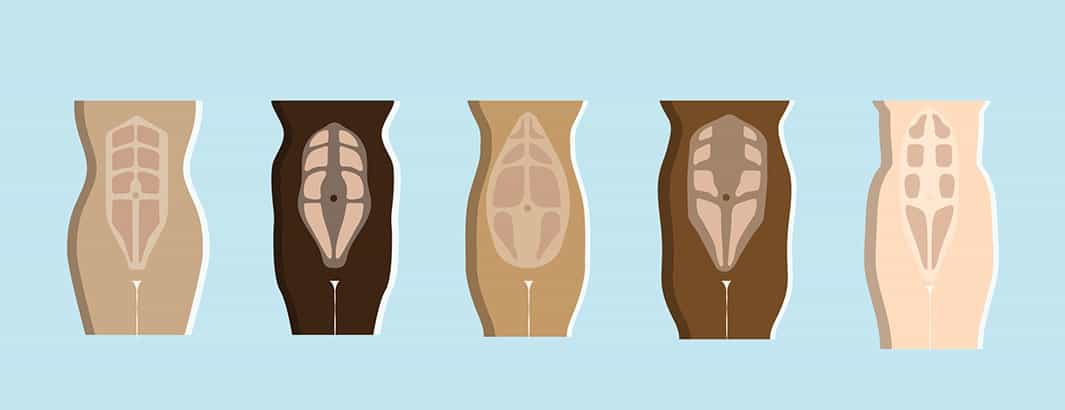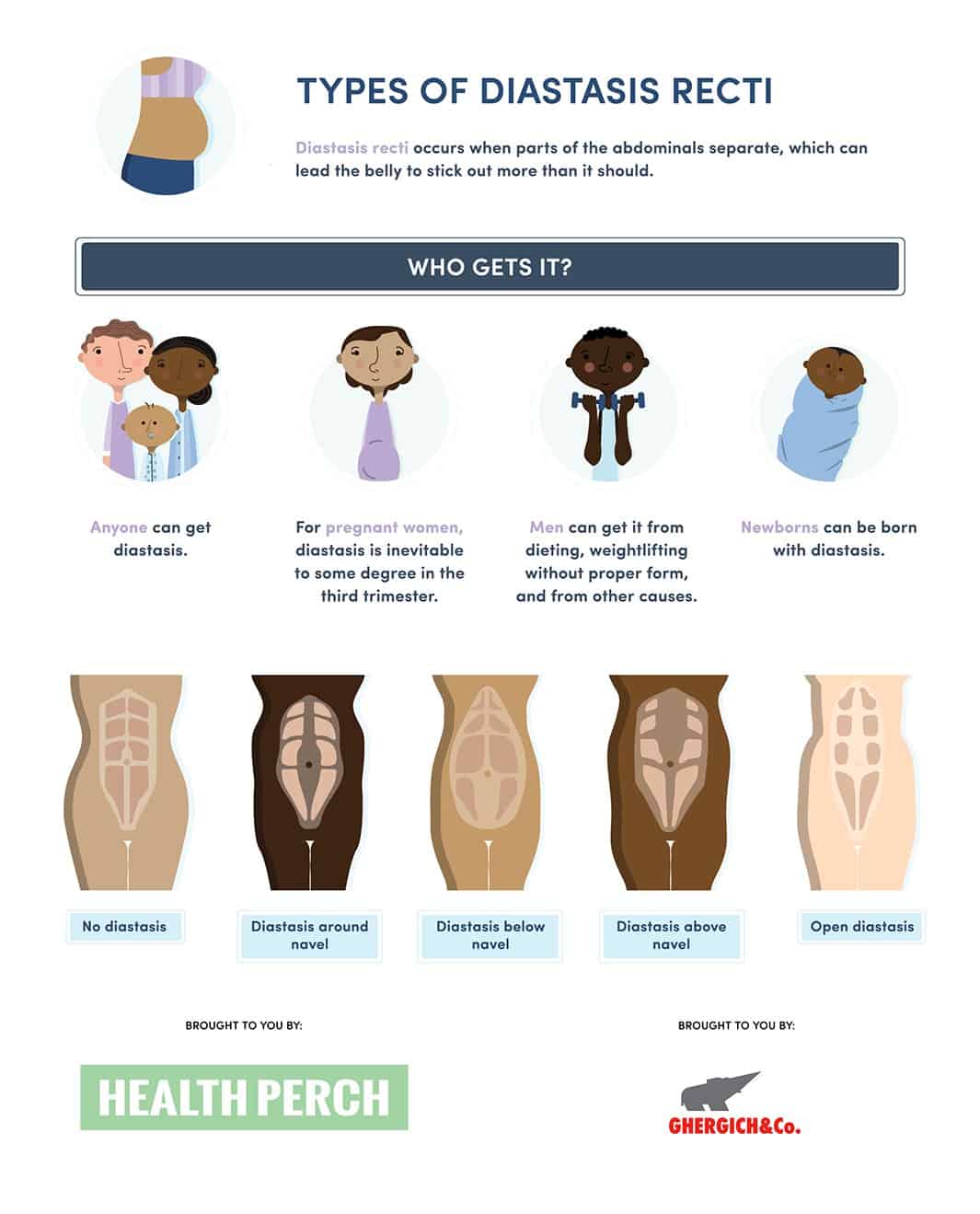What is Diastasis? And What You Can Do About it.
There are lots of events that change our bodies for us, whether we welcome those changes or not. Take pregnancy, for example. It’s great to grow a human and, well, have the baby — but there’s weight gain and other muscular changes that might happen during a pregnancy. And some of those changes can happen to people who don’t get pregnant, too. One is called diastasis recti.
What this term refers to is the splitting apart of the muscles of the front of the abdomen. It happens because it thins and weakens — normal during how the belly stretches during pregnancy. But it can also happen to men, especially if they lift incorrectly or gain a whole bunch of weight. And diastasis can occur in different areas, such as around the navel or below the navel. So what are some of the symptoms of this condition and what can you do in order to remedy it? This graphic offers some insights.
What Is Diastasis Recti?
Diastasis recti (DR) occurs when the front fascial connection between the two muscle bellies of rectus abdominis—also known as the linea alba—thins. In other words, the connective tissue that holds the two sections of your top abdominals together stretches out and weakens so it is no longer able to fully bear weight. Some diastasis and abdominal separation are normal during pregnancy and often heal on their own after childbirth. But this phenomenon isn’t limited to moms: Diastasis may also occur in men, non-childbearing women, and infants who regularly put increased pressure on the abdominal wall.
Diastasis may happen in one or multiple locations on the abdomen. Your linea alba can open around, below, or above the navel. You may also have a completely open diastasis, where you experience separation in all three areas. Knowing the location of the diastasis will help pinpoint the treatment needed to resolve the issue.
How to Check For Diastasis Recti
A true diastasis is measured when two fingers fit side-by-side between the rectus abdominis, and the tissue is soft. Normal fascial tissue between the rectus abdominis should feel like a trampoline.
To measure yourself for potential diastasis, lie on your back with your feet flat on the floor. Relax the belly and place two fingers directly below the navel. Repeat this again around the navel, and above it. If both fingers fit between the abdomen and sink deeply, then you may have DR. (Use this as a starting point but consult your doctor for a proper diagnosis.)
Depth matters more than width. If the abdomen is firm but still measures with two fingers, then the linea alba can absorb the load on the trunk. In this instance, it is common for the rectus to reclose with the right exercises and breathing patterns. The largest indicating factor is how far the fingers sink into the fascia. The more they sink, the thinner the fascia.
Why Is Diastasis Recti a Bad Thing?
The linea alba works to support the trunk by assisting in load transfer. When the gap is too large and soft, it no longer transfers load effectively, which can lead to pelvic floor dysfunction, and pain and instability in the abdomen and sacroiliac joint (SI).
It’s important to note that women need to allow time for the linea alba to heal after giving birth. Many factors come into play when it comes to healing fascia, including time since pregnancy, the number of pregnancies, overall health, inflammation, hydration, and how much stress is continually placed on the abdomen.
Is Diastasis Recti Preventable?
During pregnancy, diastasis is inevitable to some degree in the third trimester. Just because every mom gets it doesn’t mean it will become problematic after pregnancy. Many women experience DR healing by six months postpartum. There is no definitive answer when it comes to preventing diastasis during pregnancy. A 2015 study showed no difference in the development of DR between women who exercise and those who did not. However, women who still experience DR after six months postpartum likely need further intervention.
For men and non-childbearing women there are inherent risk factors when developing DR including:
- Obesity due to additional fat stores placing pressure on the linea alba
- Frequent and rapid fluctuation in weight
- Weightlifting without proper core control
- Excessive abdominal exercises
- Fluid retention from certain cancers or other disease
- Genetics
- Advanced aging
DR can also be prevalent in newborns who are premature and have not developed abdominal muscles, but this is often resolved without treatment.
How to Treat Diastasis Recti
If you perform the self-diagnostic test mentioned above and feel you may have DR, your best resource is a physical therapist (PT) or specialist with a concentration in this area of rehabilitation. A physical therapist can review your health history and provide a thorough examination to determine if you need a treatment plan.
Your PT may assess abdominal palpability to determine the degree of separation, then ask about other factors such as posture, hip or low back pain, painful intercourse, urinary or bowel incontinence, and a general feeling of weakness throughout the core.
A key component to healing DR is posture and breathing training. This type of training will teach you to move your breath through your body properly and help you learn better core control so you can strengthen and stabilize deep core muscles, such as the transverse abdominis, while avoiding overuse of the rectus abdominis.
Your therapist may also go over stretching techniques to relieve overly tight muscles, scar tissue relief if you had a C-section or other surgery that contributes to tightness. You may also be a candidate for a belly binder to provide extra support while you heal.
Additionally, your therapist will provide a good education and knowledge base so you understand the challenges presented by DR and how to avoid relapse.
What to Avoid If You Have DR
As you heal DR, it’s important to be patient. There is no quick fix and it may take time to heal. Your physical therapist will provide a comprehensive list of things to avoid while your DR heals.
However, if you are not able to see a PT immediately, here is a basic list of activities you may want to avoid for the time being.
- Holding your breath
Breath control is an important part of regulating abdominal pressure. You can safely lift a heavy object while holding your breath, but this is a learned skill. If you are not properly trained in this technique (known as the Valsalva maneuver), you may end up with pelvic or organ prolapse (meaning organs may droop or descend). The best way to avoid this is to exhale when you lift a heavy object. - Holding your belly button in
Forcefully pulling in the belly button or sucking in can also lead to pelvic prolapse as your organs are pushed out of place and forced into the pelvic floor. Try to keep the belly relaxed and soft until you need to brace for something. - Exercises or movement that causes doming
Abdominal doming is when the rectus abdominis domes or cones outward during movement. If exercises cause your abdomen to the dome—rather than remain relatively flat—then avoid them at all costs. This can worsen DR. Some exercises that may cause doming include planks, crunches, sit-ups, front squats, and jackknives. - Steer clear of front loading
Though front-loading (carrying weight in the front of your body) is safe and effective to spare your back, it’s important to not bear the brunt of any weight on your abdominals when your core is trying to heal. Front loads include the exercises listed above, but also carrying heavy loads such as big boxes, heavy laundry baskets, and other large items that can cause tension on your abs. If you need to do the heavy lifting, wear your belly binder, and recruit help or use a support device like a wagon or pushcart.
Conclusion
Diastasis recti can be healed completely and quickly, even if you’ve had it for years. It’s important to work with a specialist who can properly assess you and get you on the right treatment plan. Eating well, drinking enough water, and getting enough sleep are also important components for healing faster.
Written and Shared with permission by BY


